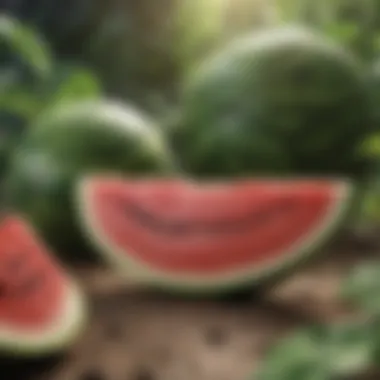Exploring Watermelon: Nutrition, Culture, and Ecology


Intro
Watermelon is more than just a refreshing fruit enjoyed on hot summer days. It is a complex entity that holds significant nutritional, cultural, and historical importance. The journey of watermelon begins in its botanical classification and extends to its various roles across diverse cultures.
This article aims to dissect the many layers associated with watermelon. Not only will we delve into its rich nutritional profile, but we will also explore its impact on our diets, the history of its cultivation, and the environmental considerations tied to its production. In addition, there will be insights into the relationship between watermelon and certain wildlife, broadening the scope of understanding to the interconnectedness of nature. Ultimately, this exploration serves to enrich our appreciation for watermelon and its various associations in our lives.
Nutritional Benefits
Watermelon is predominantly composed of water, making it an excellent choice for hydration. It also contains vital vitamins and minerals essential for human health. The following highlights the nutritional benefits of this beloved fruit:
- Rich in antioxidants: Watermelon contains lycopene, which may provide protection against certain types of cancers.
- Hydration: With approximately 92% water content, watermelon is one of the most hydrating fruits available.
- Low in calories: A standard serving is low in calories but high in essential nutrients, offering a guilt-free treat.
- Vitamins: Includes significant amounts of Vitamin C, A, and some B vitamins.
Historical Significance
The origins of watermelon can be traced back thousands of years. Initially domesticated in Africa, it has since spread across the globe. Understanding its history sheds light on its importance in various cultures:
- Ancient Egypt: Watermelon seeds were found in ancient Egyptian tombs, highlighting its esteemed status as a food source.
- Asia and Beyond: Cultivation spread to Asia and Europe, adapting to local environments and preferences.
- Modern Cultivation: Today, watermelon is cultivated in many countries, with China being the largest producer.
Cultural Aspects
Watermelon holds a prominent position in cultural traditions and social gatherings. Its consumption is linked to numerous festivities and celebrations:
- Summer Picnics: Often associated with family gatherings, watermelon adds a refreshing touch to warm-weather picnics.
- Cultural Festivals: Various cultures celebrate watermelon, incorporating it into festivals and community events.
- Symbolic Significance: In some cultures, watermelon symbolizes prosperity and abundance.
Environmental Impact
The cultivation of watermelon does not come without its challenges. As we explore its role in modern agriculture, attention to sustainability is crucial. Key environmental aspects include:
- Water Usage: Considering its high water content, optimal irrigation practices are essential.
- Soil Health: Sustainable farming techniques can improve watermelon yield while preserving soil integrity.
- Pesticide Use: Awareness of chemical use in cultivation is important for both consumer health and environmental safety.
Ending
The exploration of watermelon reveals its importance not just as a food source, but as a cultural and environmental touchstone as well. Understanding its nutritional benefits, historical significance, and the role it plays in culinary practices provides a comprehensive view of this fruit. Consequently, a deeper appreciation for the relationship between watermelon and the natural world can foster more conscious consumption and cultivate a greater respect for wildlife interactions with this familiar fruit.
Watermelon is not just a fruit; it's a vital part of cultural heritage and an essential component of balanced nutrition.
Preface to Watermelon
Watermelon, a vibrant and hydrating fruit, has captured human interest for centuries. Understanding the watermelon provides valuable insights into its myriad benefits, both nutritionally and culturally. This section leads readers through the important aspects of the watermelon, emphasizing its relevance in diets around the world and its cultural significance. Watermelon is not just a sweet treat; it is a symbol of summer gatherings and celebrations. Engaging with its qualities enriches our connection to land and living beings.
Botanical Classification
Watermelon belongs to the Cucurbitaceae family, which includes other fruits like cucumbers and pumpkins. Its scientific name is Citrullus lanatus. This classification highlights its evolutionary path and adaptability. The taxonomy reveals relationships between different species, which can be of interest to both botanists and casual readers. Understanding its botanical roots helps clarify how it has changed through cultivation.
Physical Characteristics
Size and Shape
Watermelon varies widely in size and shape, typically appearing oval or round. The average weight can range from 5 to over 30 pounds. This variability is interesting as it caters to different consumer preferences. Larger watermelons tend to be preferred for gatherings where many share. In contrast, smaller varieties are suitable for individual consumption or small families. The size and shape also contribute to storage and transport considerations, which are key in agricultural practices.
Color and Texture


The outer skin of watermelons displays a striking green color, often with lighter stripes. Beneath this tough skin lies the juicy flesh, ranging from deep red to yellow hues. The contrast in color can signify different varieties and taste profiles, enriching the market. The smooth texture of the rind contrasts with the soft, succulent flesh inside. This texture difference plays a significant role in consumer preference and affects how the fruit is handled and consumed.
Taste Profile
The taste of watermelon is primarily sweet, with a high water content that provides its refreshing quality. This natural sweetness makes it a favorite ingredient in various dishes and beverages. Its flavor can be influenced by factors such as ripeness and variety. Some watermelons have more complex profiles with hints of floral or citrus notes, adding diversity to culinary uses. This taste appeal is crucial in discussions about its nutritional value and popularity as a summer fruit.
Watermelon is not only a delicious fruit but also a bridge connecting culinary traditions and cultures across the world.
Engaging with the aspects of watermelon discussed in this section forms a basis to appreciate its nutritional value, historical context, and its role in contemporary culture.
Nutritional Value of Watermelon
Watermelon is not only a popular summer fruit but also a powerhouse of nutrition. Its nutritional value is a key topic that offers insights into how it can benefit overall health. Understanding these aspects can help individuals incorporate watermelon into their diets effectively. The nutritional components of watermelon play a significant role in hydration, immune support, and overall wellness. This section explores the vitamins, minerals, and caloric content found in watermelon, emphasizing their importance.
Vitamins and Minerals
Vitamin
Vitamin C is one of the standout nutrients in watermelon. This vitamin acts as a potent antioxidant, helping to fight free radical damage in the body. A single serving of watermelon can provide over 20% of the daily recommended intake of Vitamin C. Its anti-inflammatory properties can contribute to better skin health and immune function.
Moreover, Vitamin C is a water-soluble vitamin, meaning the body cannot store it. Regular consumption of watermelon can help maintain adequate levels. However, it is important to consume it fresh, as cooking or processing can reduce Vitamin C levels significantly.
Vitamin A
Vitamin A is another significant nutrient present in watermelon. It is crucial for maintaining healthy vision and immune function. The body converts beta-carotene into Vitamin A, which is abundant in watermelon. This nutrient not only supports eye health but also plays a vital role in skin maintenance and cellular growth.
Including watermelon in the diet can enhance Vitamin A intake without adding excessive calories, making it an excellent option for those looking to enrich their diets with essential nutrients. However, it’s important to consume it in moderation, as excessive intake may lead to imbalances in nutrient levels.
Other Nutrients
Beyond Vitamin C and A, watermelon contains several other important nutrients. These include potassium, which is essential for heart health and regulation of blood pressure. It also contains magnesium and fiber, promoting digestion and overall well-being.
The presence of antioxidants and amino acids in watermelon contributes to its health benefits. For instance, lycopene, a powerful antioxidant found in watermelon, has been linked to reduced risks of certain chronic diseases. This unique combination of nutrients makes watermelon a beneficial choice for enhancing dietary variety and nourishment.
Hydration Benefits
Watermelon is composed of about 90% water, which significantly contributes to hydration. During hot weather, consuming watermelon can be an excellent way to replenish fluids. The high water content along with its natural sugars makes it a refreshing and energizing choice. Staying hydrated is important for maintaining bodily functions, including temperature regulation and nutrient transport. This hydrating property makes watermelon a favored fruit, especially in warmer climates.
Caloric Content
The caloric content of watermelon is another aspect worth noting. It is low in calories, with only about 30 calories per 100 grams. This low-calorie nature allows individuals to indulge in it without excessive calorie intake. As a result, watermelon can be a great option for those looking to manage their weight while still enjoying a tasty and satisfying fruit. Its natural sweetness also makes it a healthy alternative to sugary snacks.
Historical Significance of Watermelon
Watermelon holds not only nutritional value but also a rich historical significance that spans across cultures and eras. Understanding this aspect enhances our appreciation of the fruit's role in human history and social customs. The exploration of its origin and early cultivation highlights how watermelon became a staple in various diets worldwide. Additionally, its cultural symbolism across festivals and literature showcases how deeply the fruit is woven into the fabric of societies.
Origin and Early Cultivation
Africa's Role
The origin of watermelon is deeply rooted in Africa, where it first grew in the wild. Evidence suggests that this fruit was domesticated in various regions of West Africa. Notably, the ability of watermelon to thrive in arid climates makes it an invaluable crop for local farmers. The presence of natural sugars and high water content enhances its desirability, especially in hot environments.


Africa’s role is significant; it not only provided the initial habitat for wild watermelons but also developed cultivation techniques. African communities depended on watermelon for hydration during dry spells, creating a vital connection between the climate and the agricultural practices of the region. This dependence characterizes watermelon as more than a fruit; it is a symbol of survival and resourcefulness that reflects the challenges faced by early cultivators.
Spread to Other Regions
As trade routes expanded, watermelon found its way out of Africa into the Mediterranean and other parts of the world. The unique feature of watermelon is its ability to be preserved in various culinary forms, making it suitable for long journeys. This adaptability is a key characteristic in understanding its spread.
The introduction of watermelon to different cultures brought diverse culinary applications, enriching the dishes of each region. As it traveled, the fruit adapted to different climates and tastes, allowing it to evolve and integrate into various cuisines. However, the challenges of cross-continental farming practices and the introduction to unfamiliar pests posed disadvantages that farmers had to overcome.
Cultural Symbolism
Festivals and Traditions
Watermelon is often featured in summer festivals and celebrations around the world. Its juicy texture and vibrant color make it a prominent dish on tables during warmer months. For instance, in the southern United States, watermelon is a staple at picnics and family gatherings, symbolizing community and joy. The key characteristic of this custom is its ability to bring people together, emphasizing the fruit’s role in fostering social bonds.
Additionally, various cultures have traditional rituals associated with watermelon, such as competitive seed spitting contests, showcasing the playful spirit surrounding this fruit. Incorporating watermelon into festivals enhances its cultural significance and broadens its role beyond mere consumption.
Watermelon in Literature and Art
Watermelon also appears frequently in literature and art, evoking themes of nostalgia and simplicity. Authors and artists have used watermelon as a symbol of abundance and summer, reflecting its deeper connection to human experiences. The key aspect of this representation is how it evokes memories and emotions linked to warmer days.
This portrayal can be substantial, as it indicates the fruit’s place in the human narrative. However, the artistic focus on watermelon may lead to oversimplifying its broader cultural significance. Understanding these representations within context can bring greater appreciation for the complexity of both watermelon and the human experience.
Contemporary Uses of Watermelon
The modern world has seen numerous ways to integrate watermelon into daily life. Understanding these contemporary uses highlights watermelon’s versatility in our diets and culture. This section will delve into culinary applications and popular culture, showcasing how watermelon remains relevant across generations.
Culinary Applications
Raw Consumption
Raw consumption of watermelon is one of its most straightforward yet delightful aspects. Eating watermelon fresh preserves its natural sweetness and juiciness. This choice is especially popular during summer months when people seek hydration and refreshing flavors. Watermelon can be sliced, cubed, or eaten in wedges, making it a versatile option for breakfasts, snacks, or desserts.
One key characteristic of raw consumption is its simplicity. It requires no preparation beyond slicing and serves as a quick, healthy option for families and individuals. No additional ingredients are necessary, preserving the fruit’s unique flavor. The advantage is that it offers maximum nutritional benefits, including vitamins and hydration. However, for those looking for more complex meals, eating watermelon raw may seem too mundane.
Culinary Innovations
Culinary innovations have transformed how we perceive watermelon in contemporary cooking. Chefs and home cooks alike experiment with the fruit in ways that challenge traditional boundaries. Watermelon is now found in salads, salsas, and even grilled dishes. Adding watermelon to savory recipes introduces new flavor profiles, enhancing dishes with a touch of sweetness and color.
The beneficial aspect of these innovations is their ability to elevate the fruit from a side dish to a main component in gourmet meals. Watermelon is paired with ingredients such as feta cheese, basil, or even chili, making it a trendy choice. The unique feature of these innovations is that they showcase watermelon’s adaptability. However, some traditionalists might prefer the fruit in its unaltered state, creating a divide in preferences.
Beverages and Cocktails
Watermelon also finds its way into the beverage industry, where it enhances cocktails and refreshing non-alcoholic drinks. Blending watermelon into smoothies or juices adds flavor, natural sweetness, and nutrients. Additionally, it is often featured in cocktails, providing a vibrant, summery appeal. The refreshing nature of watermelon-based drinks makes them ideal for social gatherings and hot days.
Key characteristic here is the versatility of watermelon in liquid form. Its high water content makes it a hydrating ingredient, which appeals to health-conscious consumers. Consequently, this advantage has led to a growing trend of watermelon-infused products. A potential disadvantage may be the seasonal availability and limited shelf life compared to other fruits, affecting production.
Watermelon in Popular Culture
As a cultural symbol, watermelon transcends mere nourishment to embody various societal connotations. This section examines media references and social media trends, revealing watermelon’s role in contemporary culture.
Media References


In media, watermelon is often depicted as a symbol of summer and joy. It features prominently in movies, television shows, and advertisements. These references emphasize community gatherings, barbecues, and celebrations, linking watermelon to positive experiences. The unique feature of media references is how they evoke nostalgia and belonging.
The beneficial aspect is that these portrayals encourage consumption and appreciation of watermelon as part of cultural celebrations. However, such depictions can sometimes overshadow its nutritional benefits, limiting public perception.
Social Media Trends
Social media trends have significantly influenced how watermelon is embraced today. Platforms like Instagram and TikTok showcase creative recipes, decoration ideas, and even challenges centered around watermelon. Hashtags related to watermelon often trend during summer, amplifying its visibility.
The key characteristic of these trends is their ability to engage a younger audience. Users share visuals that highlight watermelon in artistic ways, from fruit platters to themed parties. This exposure can lead to a resurgence in watermelon’s popularity. The advantage lies in making healthy eating appealing, though trends can sometimes be fleeting, impacting sustainability.
Environmental Impact of Watermelon Cultivation
The cultivation of watermelon is not only a matter of growing a popular fruit; it also raises important considerations about environmental sustainability. Understanding this impact is crucial as it reflects the strategies that farmers can adopt, the resources they need, and the potential effects on local ecosystems.
Sustainable Farming Practices
Sustainable farming practices aim to reduce the negative impact on the environment while still allowing for productive agriculture. For watermelon cultivation, these practices can include organic farming, crop rotation, and better soil management.
- Organic Farming: This involves using natural fertilizers and pest control methods. Organic watermelon farming helps in reducing chemicals that can leach into the soil and waterways, thus preserving water quality.
- Crop Rotation: By alternating watermelon with other crops, such as soybeans or corn, farmers can enhance soil fertility and disrupt pest and disease cycles. This reduces the need for synthetic fertilizers and pesticides.
- Soil Management: Practices like cover cropping and reduced tillage can improve soil health and enhance water retention. By improving the soil structure, farmers can promote better moisture retention and reduce erosion.
These sustainable techniques not only mitigate adverse effects on the environment but also contribute to the long-term viability of watermelon farming.
Water Usage Concerns
Watermelon plants require significant amounts of water for optimal growth, especially in warmer climates. Understanding water usage is important for maintaining water balance in agricultural areas. Over-extraction of water for irrigation can lead to depletion of local aquifers.
- Irrigation Methods: Utilizing efficient irrigation systems, such as drip irrigation, can significantly reduce water waste. This method delivers water directly to the plant’s root zone, minimizing evaporation.
- Rainwater Harvesting: Some farmers are incorporating rainwater harvesting systems to supplement their irrigation needs. This approach reduces reliance on groundwater.
Concerns about water usage are compounded by climate change, which may lead to altered precipitation patterns. Farmers need to adopt adaptive strategies to manage water efficiently.
Impact on Biodiversity
The impact of watermelon cultivation on local biodiversity can be profound. Monoculture practices can lead to a decline in native plant species and disrupt habitats.
- Habitat Disruption: Large-scale watermelon fields can displace diverse plant and animal species. Less diverse ecosystems may struggle to adapt to changes in climate and pest invasions.
- Pollinator Decline: Watermelon flowers rely on pollinators such as bees for fruit set. If watermelon farming practices do not consider pollinator habitats, this can lead to a decline in important species.
Promoting biodiverse agricultural practices, such as planting hedgerows or maintaining wildflower strips, can support pollinators and enhance biodiversity.
Assessing the environmental impact is vital for ensuring that watermelon cultivation contributes positively to both the economy and the environment, thus promoting a balanced approach to agricultural practices.
End
The conclusion serves as a vital component in this article, synthesizing all discussed elements of watermelon, from its nutritional value to its cultural significance. It provides a final reflection on the impact watermelon has on various facets of life, including health, environment, and society. Understanding these elements deepens our appreciation for this fruit and its role in our lives.
Summary of Key Insights
Throughout the article, several key insights have emerged regarding watermelon:
- Nutritional Advantages: Watermelon is rich in essential vitamins like Vitamin C and A, along with hydration benefits due to its high water content.
- Cultural Relevance: Watermelon has historical significance and is embedded in various cultures through traditions and festivities.
- Environmental Considerations: Watermelon cultivation raises concerns about resource management and biodiversity, highlighting a need for sustainable practices.
- Culinary Versatility: The fruit’s adaptability in modern cuisine showcases its relevance in contemporary society and culinary innovation.
These insights illustrate the complexity of watermelon, transforming it from just a refreshing summer snack to a symbol of cultural heritage and environmental awareness.
Future Outlook for Watermelon Cultivation and Consumption
Looking ahead, the future of watermelon cultivation and consumption appears to hinge on several critical factors. First, as consumer preferences shift towards healthier, local, and sustainably sourced foods, watermelon stands poised to remain a popular choice. This may spur further innovations in farming techniques that improve yield while minimizing ecological footprints.
Moreover, the ongoing research into enhancing watermelon varieties could lead to new cultivars with improved disease resistance and nutrition. Additionally, as awareness grows about the relationship between food production and environmental sustainability, watermelon can serve as a primary example of a crop that balances societal needs with ecological responsibilities.
As wildlife biologists and veterinarians continue to study the interactions between watermelon and various species, there may also be new discoveries about its role in local ecosystems, further emphasizing the fruit’s importance beyond human consumption.







